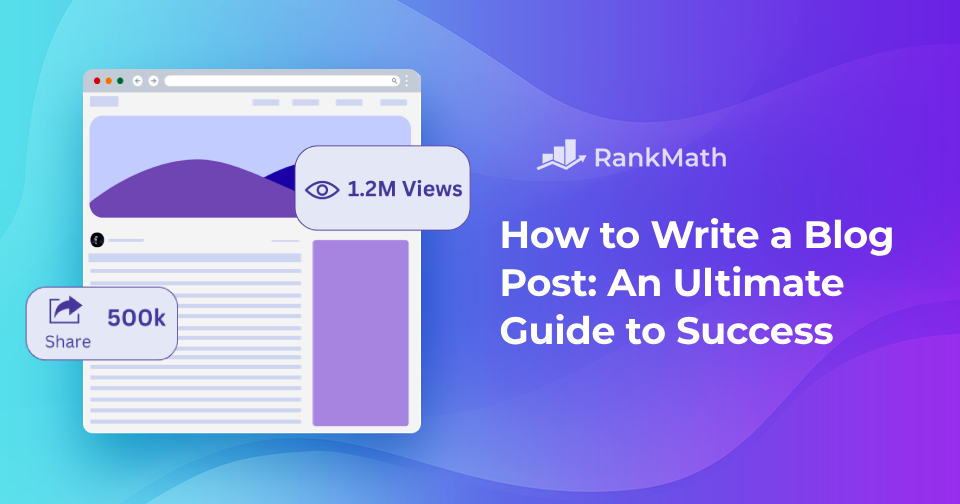Blogging is one of the most effective ways to share your ideas, build authority, and connect with a global audience.
But let’s be honest, writing a blog post can sometimes feel overwhelming.
The good news? With the right strategy and a clear structure, you can turn your thoughts into compelling content that not only informs but also engages your readers.
In this post, we’ll discuss the essential steps to write a blog post, from brainstorming ideas to publishing and promoting your work.
So, are you ready? Let’s get started.

Table Of Contents
1 Know Your Audience and Define Your Purpose
Before you start writing, take a moment to ask yourself: What do I want this blog post to achieve?
Your goal will shape your content’s tone, structure, and messaging. Are you trying to:
- Inform your readers with how-to guides or in-depth tutorials?
- Entertain them through stories, humor, or relatable anecdotes?
- Persuade them to take action—like subscribing, purchasing, or supporting a cause?
- Inspire them with motivational ideas or real-life success stories?
Whatever your goal, clarity of purpose helps you stay focused and deliver value to your audience.
But purpose alone isn’t enough—you also need to know who you’re writing for.
Start by identifying basic demographics: What’s their age group, gender, location, or education level? A post aimed at Gen Z readers will likely differ in tone and style from one targeting business professionals.
Next, dive deeper into their interests. Are they into personal finance, tech trends, wellness, or fashion? Understanding what excites your readers helps you choose topics they’ll actually care about.
It’s also important to consider their search intent—what are they really looking for when they land on your blog? Are they seeking quick solutions, in-depth research, or just browsing for inspiration?
This is where Rank Math’s Search Intent feature can give you a serious edge. It helps you uncover the “why” behind your visitors’ searches, so you can align your content to match their exact needs, boosting both engagement and conversions.
In your post/page editor, navigate to the Focus Keyword field in the General tab of the Rank Math meta box.
Enter a keyword, and you’ll notice an icon next to it. Hover over this icon and click on the Show Intent label. Rank Math will analyze and display the detected search intent next to the keyword field, helping you quickly determine whether your content aligns with what users are looking for.
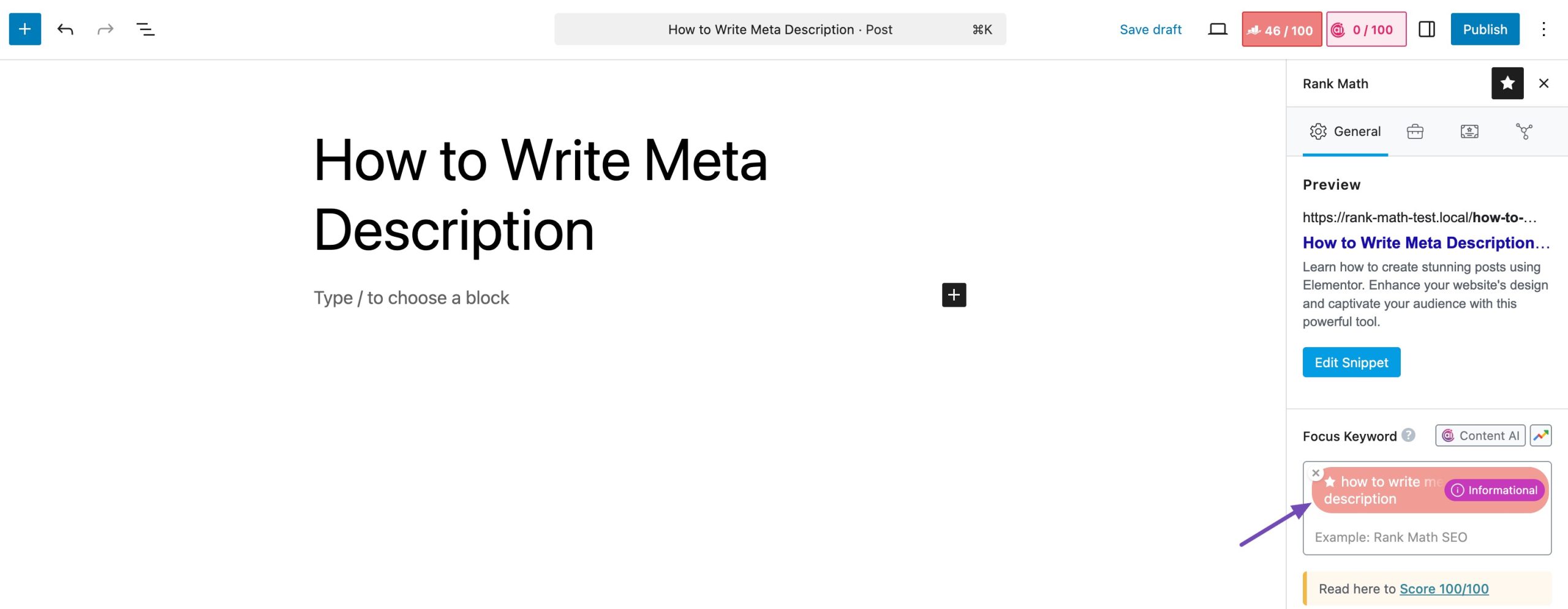
Finally, identify your audience’s pain points. What challenges are they facing? When your blog directly addresses their struggles, it becomes a valuable resource, and they’ll be far more likely to come back for more.
2 Choose a Captivating Topic
Choosing a blog post topic can be a challenging task.
2.1 Brainstorm a List of Potential Topics
One of the biggest hurdles in blogging is picking the right topic, something that captures your audience’s attention and aligns with your expertise.
A great way to start? Brainstorm a list of potential topics. Don’t worry about being perfect at this stage, just get your ideas down.
Think about:
- Common questions your audience asks
- Current trends or events in your niche
- Your own experiences, skills, and passions
- Gaps in your competitors’ content
And here’s something interesting, 78% of AI users rely on 1-3 AI tools, and over half of them are satisfied with the outcomes.
You can use our Blog Post Idea AI tool to generate blog ideas within your niche or industry faster.
Note: You must enable the Content AI module from Rank Math’s dashboard in order to use its features.
Next, select the Blog Post Idea tool by navigating to Rank Math SEO → Content AI → AI Tools from your WordPress dashboard.
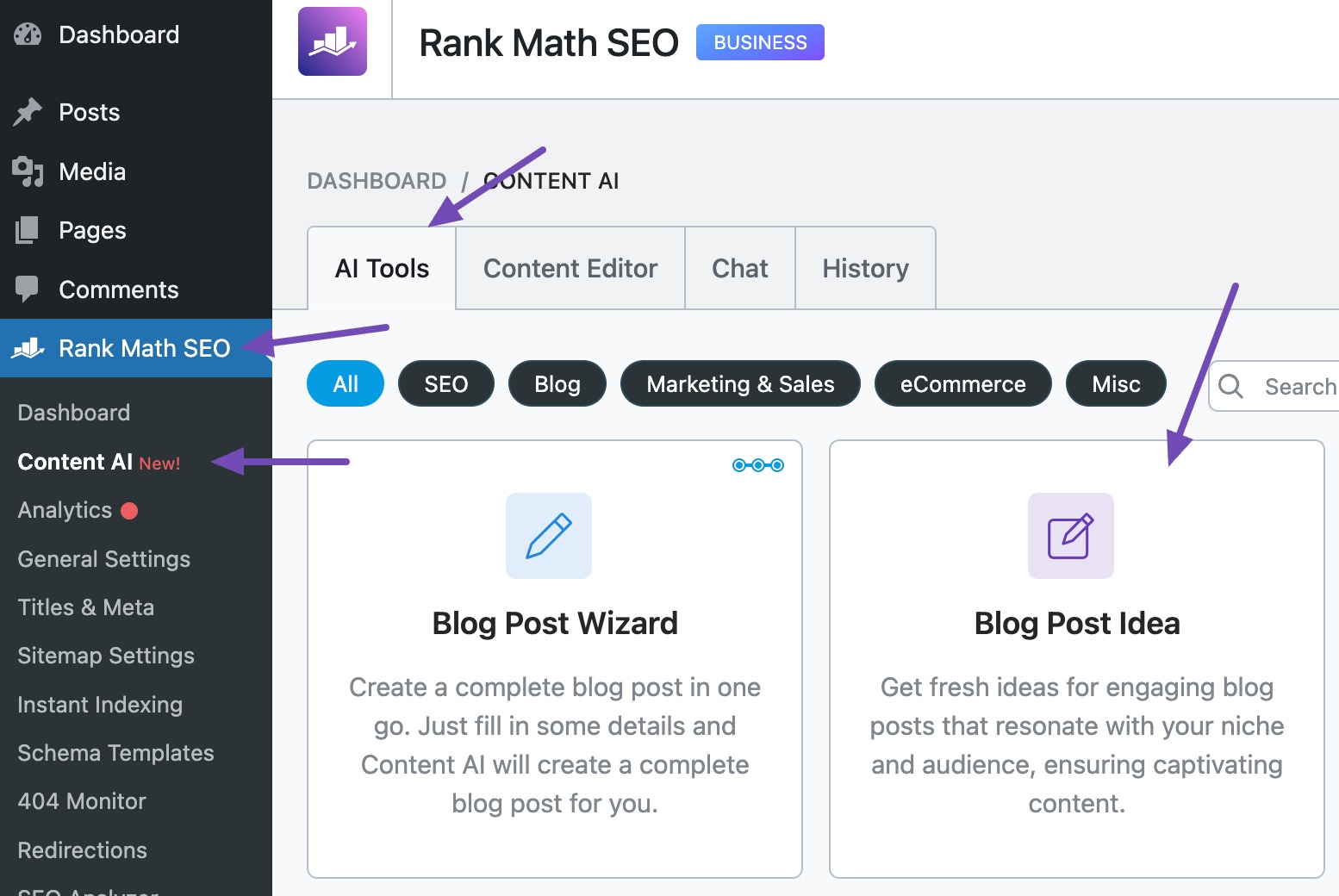
Enter all the relevant details, and our tool will generate blog post ideas for your niche based on the details provided.
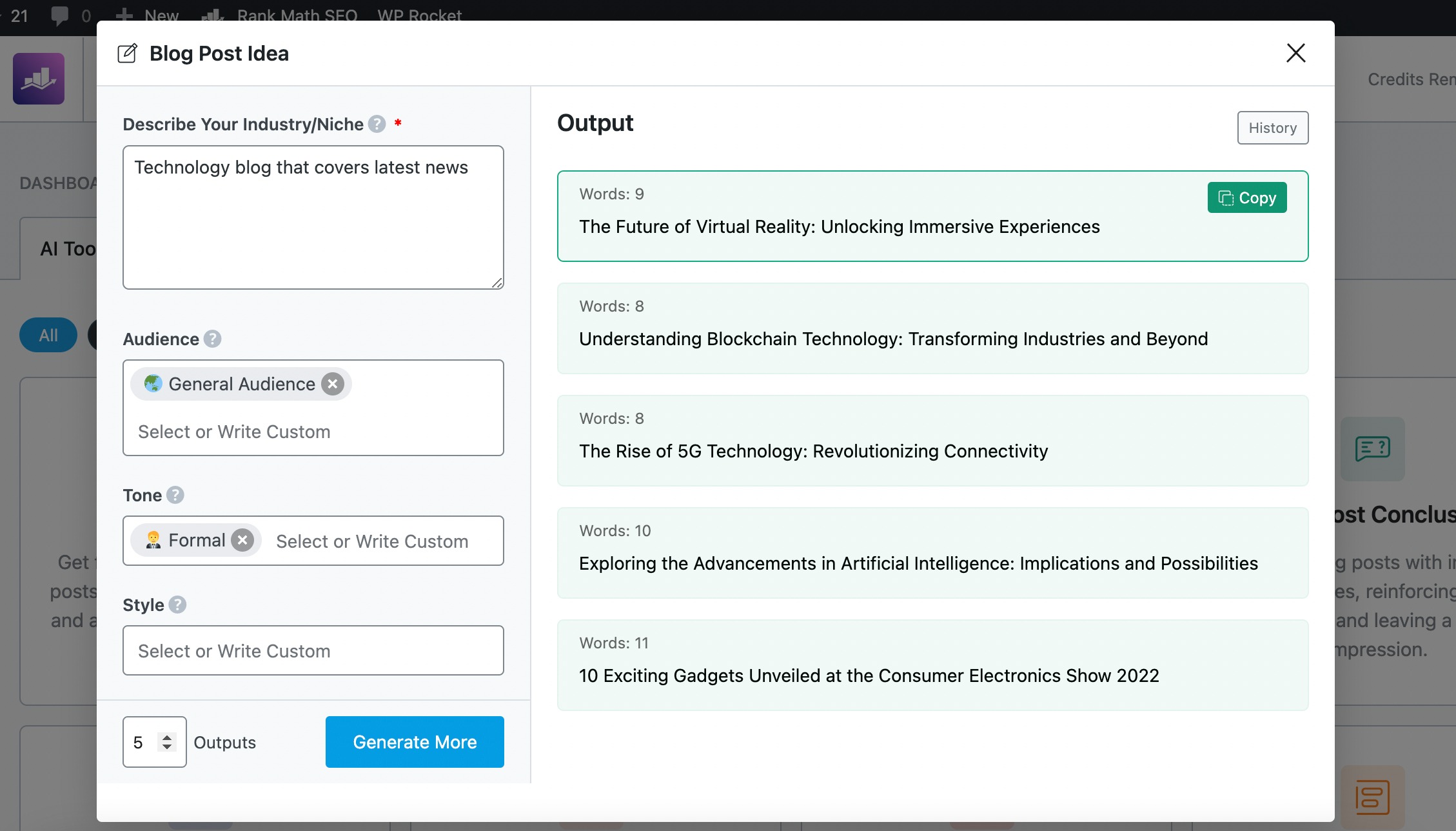
You can also explore tools like:
- Google Trends – to spot what’s currently buzzing
- AnswerThePublic – to uncover common questions
- Chrome extensions like Keyword Surfer or Ubersuggest – to identify keyword-backed topic opportunities
Before finalizing your topic, ask yourself:
- Will this interest my readers?
- Does it solve a problem or answer a common question?
- Is it timely and relevant?
- Can I offer a unique perspective?
When you choose a topic based on both data and audience needs, you’re already setting your post up for success.
2.2 Conduct Keyword Research to Find Popular and Relevant Topics
Once you have a list of potential topics, the next step is to conduct keyword research.
Begin by identifying broad terms related to your business, products, or services. These are known as seed keywords, and they serve as the foundation for your keyword research.
Next, use keyword research tools like Google Keyword Planner, Semrush, or Ahrefs to expand your list. These tools help uncover related keyword ideas and provide useful data such as search volume, competition level, and cost-per-click estimates.
To use Google Keyword Planner, log into your Google Ads account and navigate to the Tools menu.
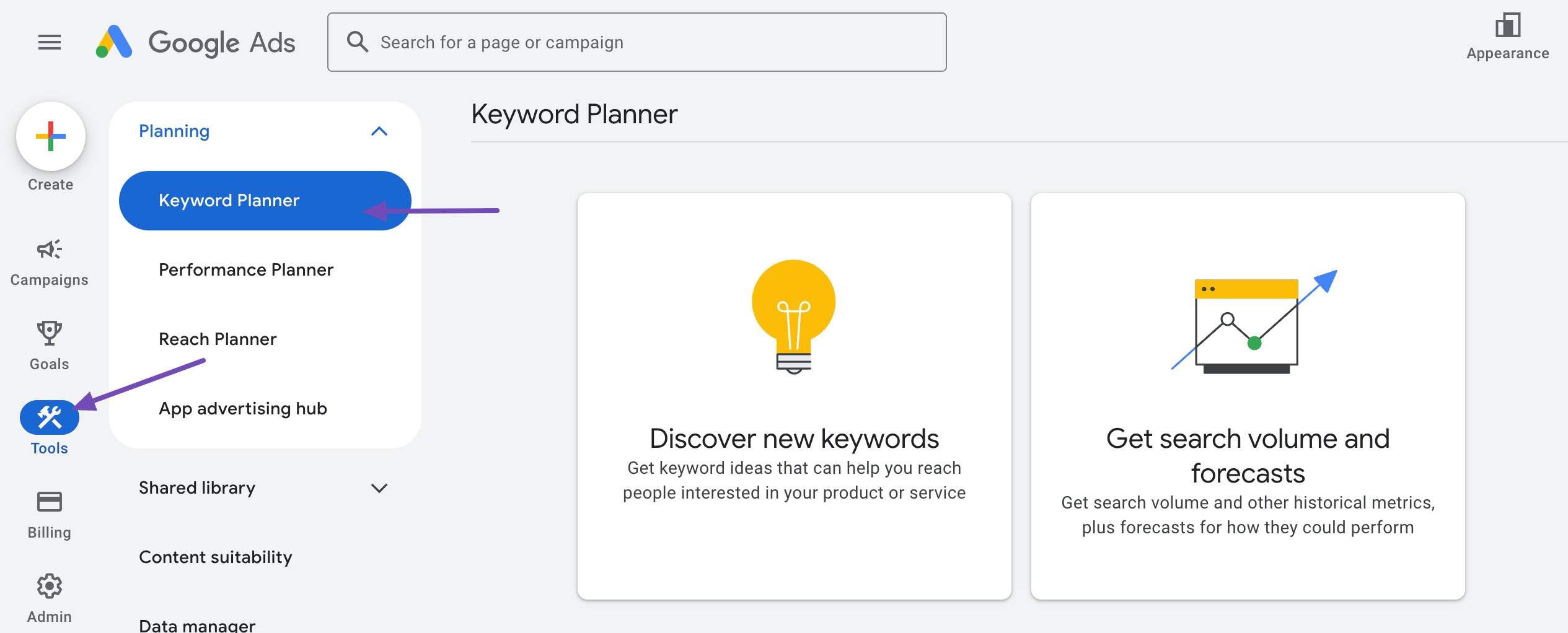
Under the Planning section, click on Keyword Planner and select the Discover new keywords option. Enter your seed keywords or your website URL to generate a list of keyword suggestions.
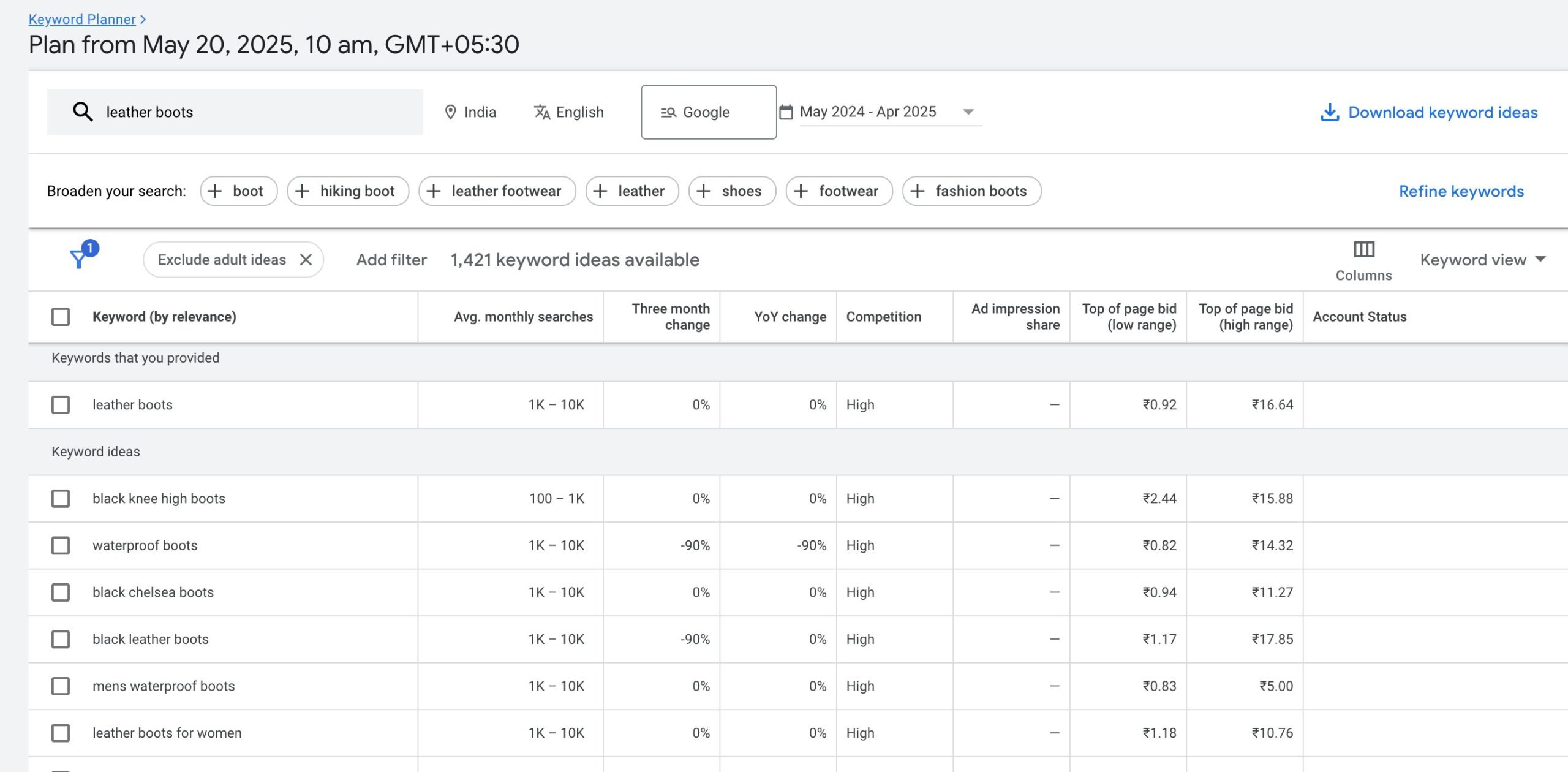
The tool will display important metrics like monthly search volume, competition level, and top-of-page bid estimates. You can refine the results by filtering for location, language, or date range.
Focus on keywords that strike a balance between high search volume and low to medium competition, and save or export your selected keywords for future use.
In addition to broad terms, look for long-tail keywords—longer, more specific phrases that reflect detailed search intent. These keywords often have lower competition and higher conversion rates, making them ideal for targeting niche audiences.
Avoid keyword stuffing, which can make your content hard to read and may negatively impact your SEO.
Refer to our dedicated tutorial on keyword research and explore the core concepts, techniques, and strategies to perform keyword research.
2.3 Select a Topic That Aligns With Your Purpose and Audience
Once you’ve done your keyword research, it’s time to narrow down your list and choose a winning topic.
Look for a topic that not only has solid search potential—like decent search volume and manageable competition—but also aligns with your blog’s overall purpose.
Your chosen topic should strike a balance between SEO strategy and audience connection. For example, if your goal is to help small business owners manage their time better, a keyword like time management tips for entrepreneurs can hit the sweet spot.
Ultimately, select a topic that serves your audience’s needs while staying true to your blog’s mission. When your topic is both searchable and meaningful, you’re setting your content up for real impact.
3 Do Your Research
Great blog posts are built on solid research. Whether you’re writing a how-to guide or sharing expert insights, your content should be backed by credible, up-to-date information.
Start by gathering facts and data from trustworthy sources—think books, academic journals, respected news outlets, and expert-authored websites. Make sure your sources are current and relevant to your topic.
To save time and streamline the process, you can use our Topic Research AI tool. It helps uncover accurate information, trending ideas, and relevant data points—doing the heavy lifting so you can focus on writing.
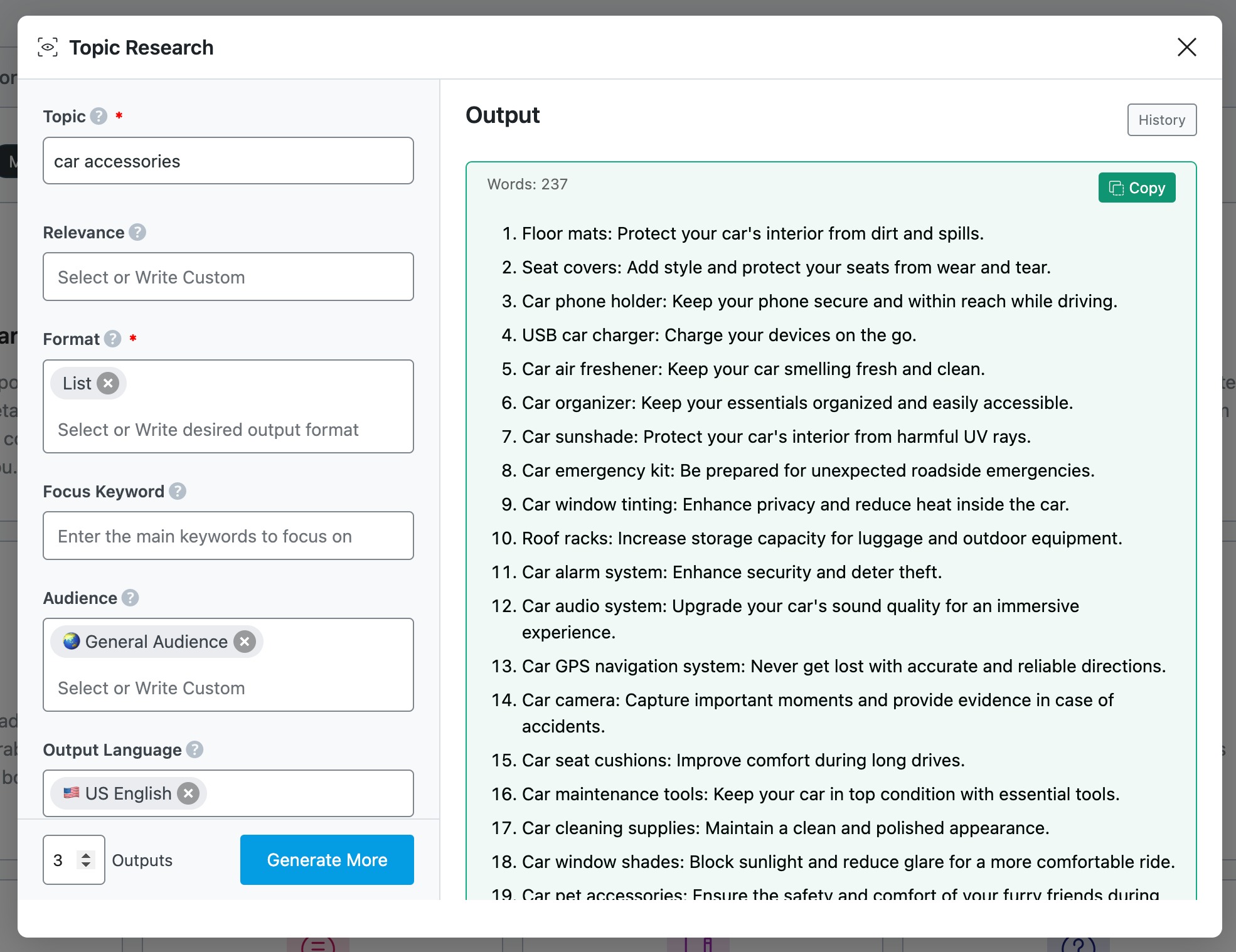
As you research:
- Take clear notes and highlight important statistics or quotes.
- Cross-check key facts across multiple sources for accuracy.
- Pay attention to the credibility of authors and organizations behind the information.
If you come across conflicting details, dig deeper. Look for original sources, date of publication, and expert consensus to determine what’s trustworthy.
Remember: well-researched content not only strengthens your blog but also builds trust with your readers. Your audience will keep coming back if they know they can rely on you for accurate, insightful content.
4 Create an Outline
Before diving into writing, take time to create a well-organized outline—it’s one of the best ways to stay focused, avoid writer’s block, and ensure your blog flows logically from start to finish.
Start by identifying the core ideas or sections you want to include. Think about the natural progression of your topic:
- What should readers learn first?
- What supporting points come next?
- How will you wrap it up with a strong conclusion?
Once you’ve mapped out your main sections, break each one into smaller sub-points. These can include key details, examples, or insights that support the larger idea.
Here’s an example of how our outline might look if we were writing a blog post on building a website using WordPress.
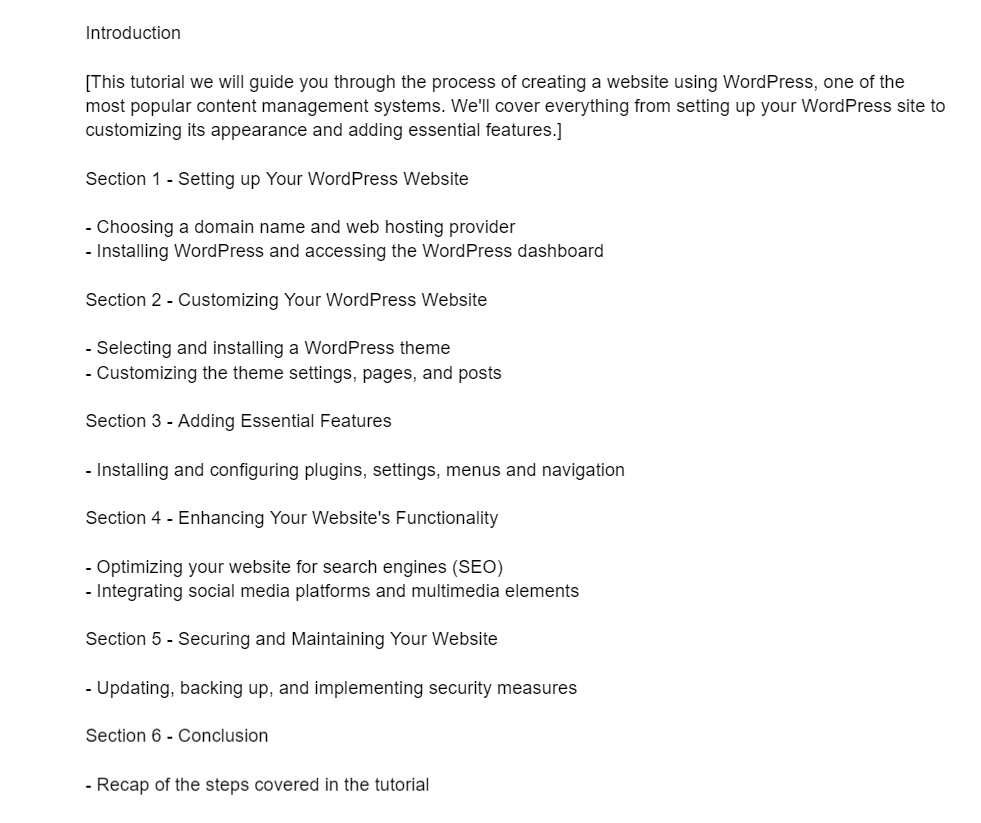
With an outline like this, you’re ready to go.
Our Blog Post Outline AI tool can expedite the outlining process. Enter the topic and our tool will generate an outline for you.
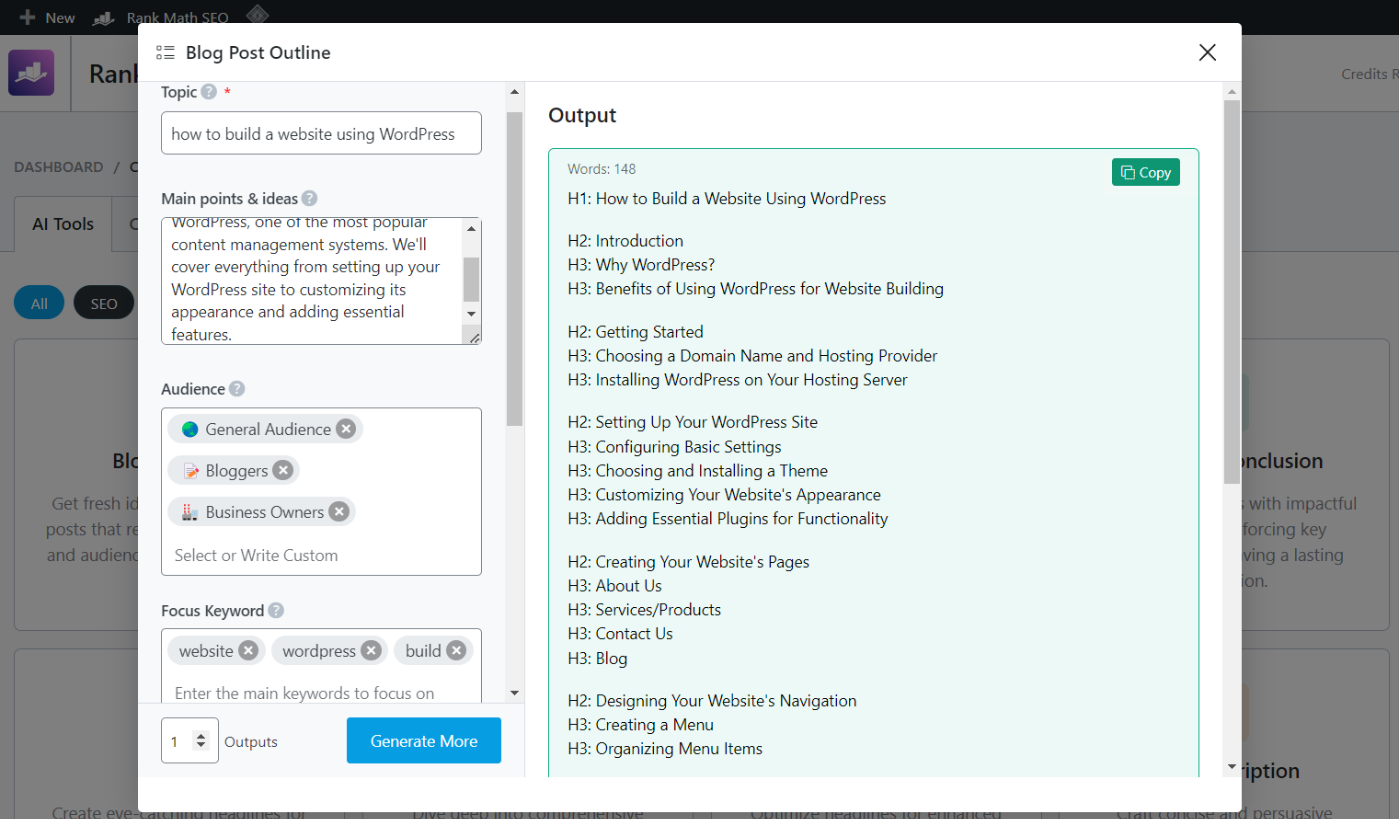
5 Start Writing Your Content
Once you’ve gathered ideas on what to write about and identified relevant keywords, you can start writing your content.
5.1 Create a Captivating Title or Headline
Your blog post’s title is the first impression readers will have, so it’s important to make it catchy and compelling. A great title grabs attention and entices readers to click and read more.
Here are some strategies to create a headline that compels clicks:
- Keep it Short & Sweet: Aim for around 70 characters or less. Readers are busy scanning online content, so a concise headline is more likely to be read and understood.
- Power Up Your Words: Use strong verbs and action words to create a sense of urgency or excitement. Power words like “ultimate,” “master,” or “proven” can pique curiosity and make readers want to learn more.
- Highlight the Benefit: Readers are reading your blog for a reason. What value will they gain from your post? Highlight the benefit they’ll receive in the headline. For example, instead of ‘Website Design Tips,’ try ‘Build a Website That Converts Visitors into Customers.’
- Spark Curiosity: Tease a bit of mystery or ask a thought-provoking question. Make readers want to uncover the answer by clicking on your post.
- Numbers and lists Grab Attention: Readers are drawn to lists and numbered formats. Headlines like ‘5 SEO Mistakes You Might Be Making‘ can be visually appealing and informative.
- Incorporate Keywords Naturally: Integrate your target keywords into your headline, but ensure they flow naturally and don’t compromise readability. Avoid keyword stuffing, which can make the headline sound forced or spammy.
5.2 Write an Engaging Introduction
You’ve created a captivating headline, and a reader clicks on your blog post. Now what?
The introduction of your blog post should begin with a hook that grabs the reader’s attention.
Here’s how to make that first impression count. Open with a surprising fact, a thought-provoking question, or a relatable anecdote. For example:
- Surprising Fact: Did you know that the average attention span online is now shorter than a goldfish’s? That’s why it’s crucial to grab a reader’s attention quickly!
- Thought-Provoking Question: Do your blog posts feel like they’re not getting much attention? You’re not alone! What if a few simple changes could make your content go from being ignored to getting cheers?
- Relatable Anecdote: Have you ever worked hard on a blog post, only to see it hardly get any views? I’ve been there too. But don’t worry, there’s hope!
- Emphasize Statistics: While not always necessary, statistics can add impact. For example, ‘Did you know that up to 15,000 WordPress websites were hacked daily in 2023?’ can be effective depending on your topic.
After capturing the reader’s attention with a hook, introduce the topic of your blog post. Clearly explain what the post will be about and why it matters.
Next, clearly state the purpose of your blog post. Let readers know what they can expect to gain from reading it. This sets clear expectations and provides a roadmap for the rest of the post.
Refer to our dedicated tutorial on how to write an introduction to write captivating introduction.
If you find it difficult to write an introduction, you can use our Blog Post Introduction AI tool. To do so, navigate to Rank Math SEO → Content AI → AI Tools from your WordPress dashboard. Select the Blog Post Introduction tool, as shown below.
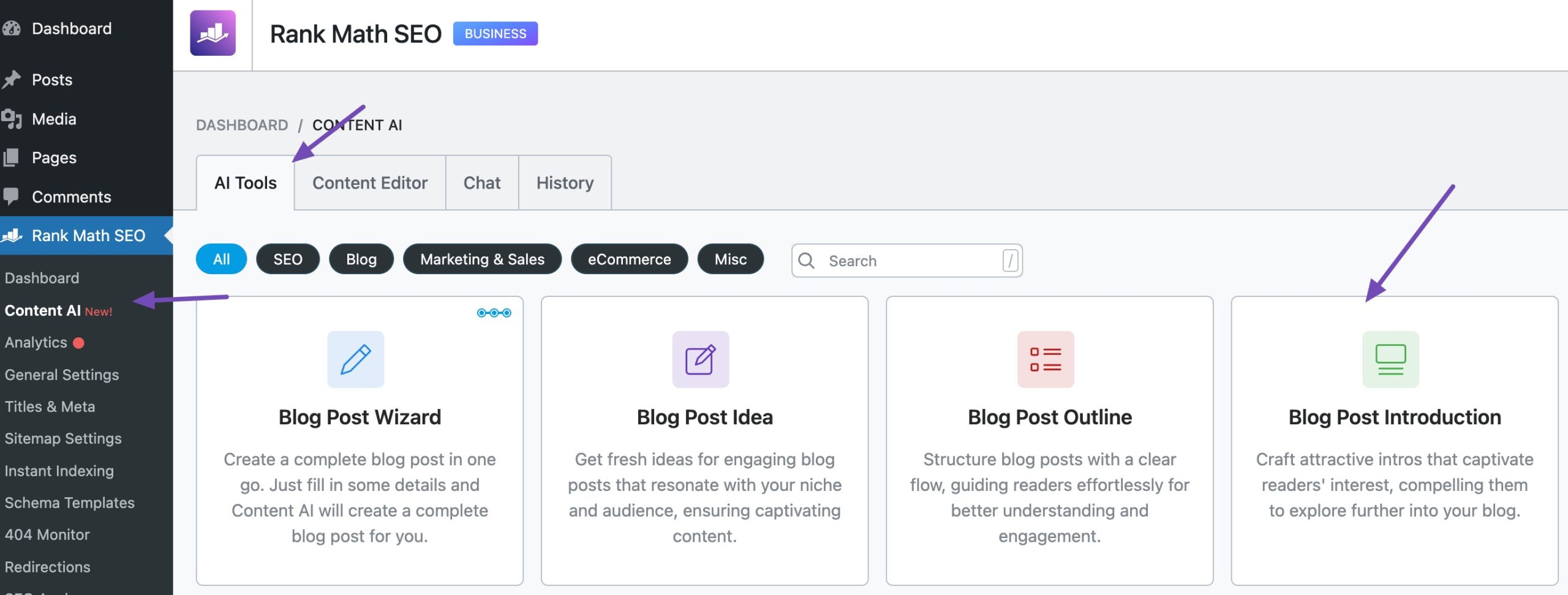
Enter your post title, which is a required field. You can also fill in the other fields, and the tool will generate an introduction quickly.
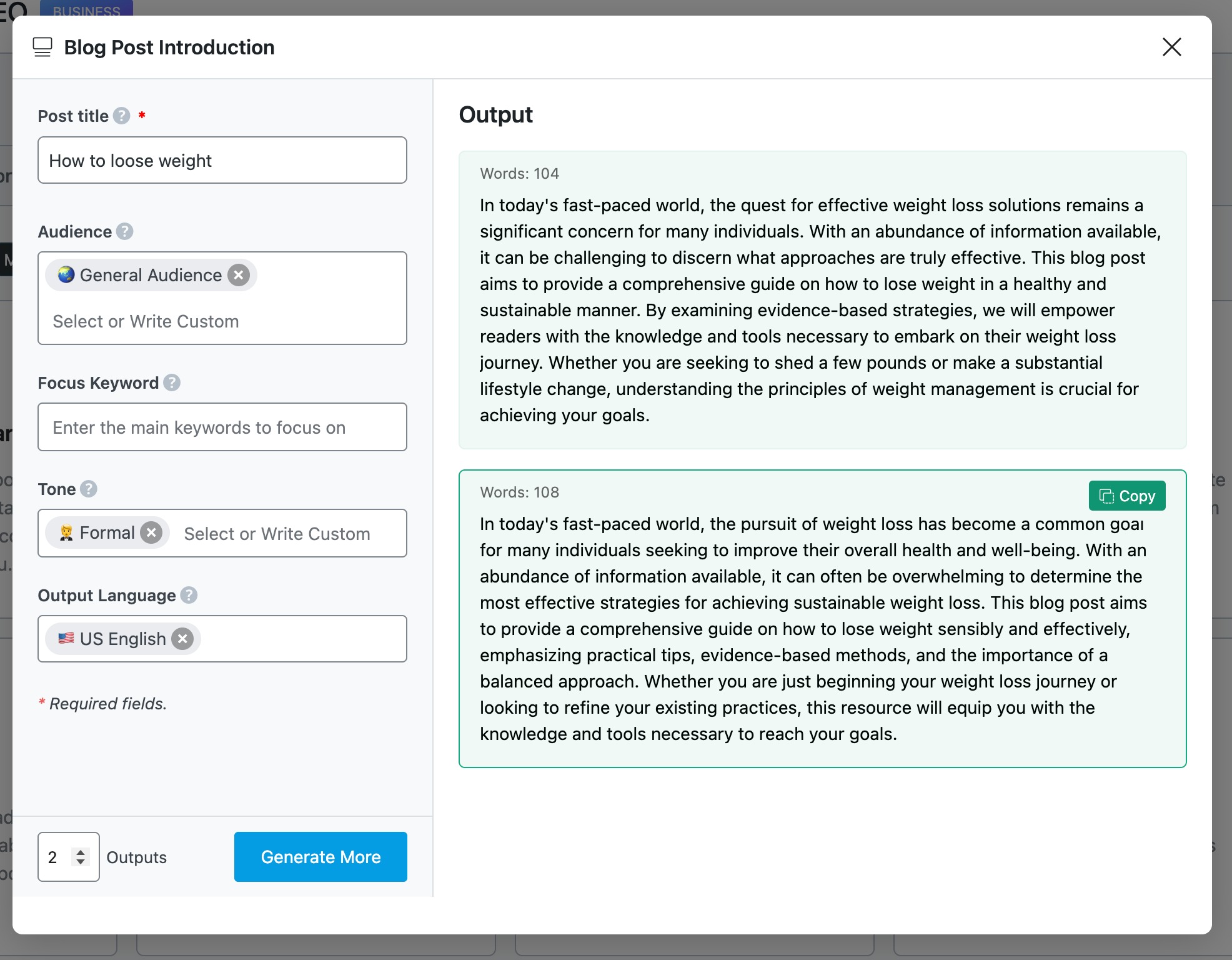
You can then use this introduction in your blog post.
5.3 Write Compelling Content
With a captivating headline and an engaging introduction, you’ve set the stage for success.
Now it’s time to write the heart of your blog post – the content that informs, engages, and inspires your readers.
Rank Math’s Blog Post Wizard AI tool helps to write compelling content entirely from scratch.
Once done, select the Blog Post Wizard tool from over 40+ AI tools.
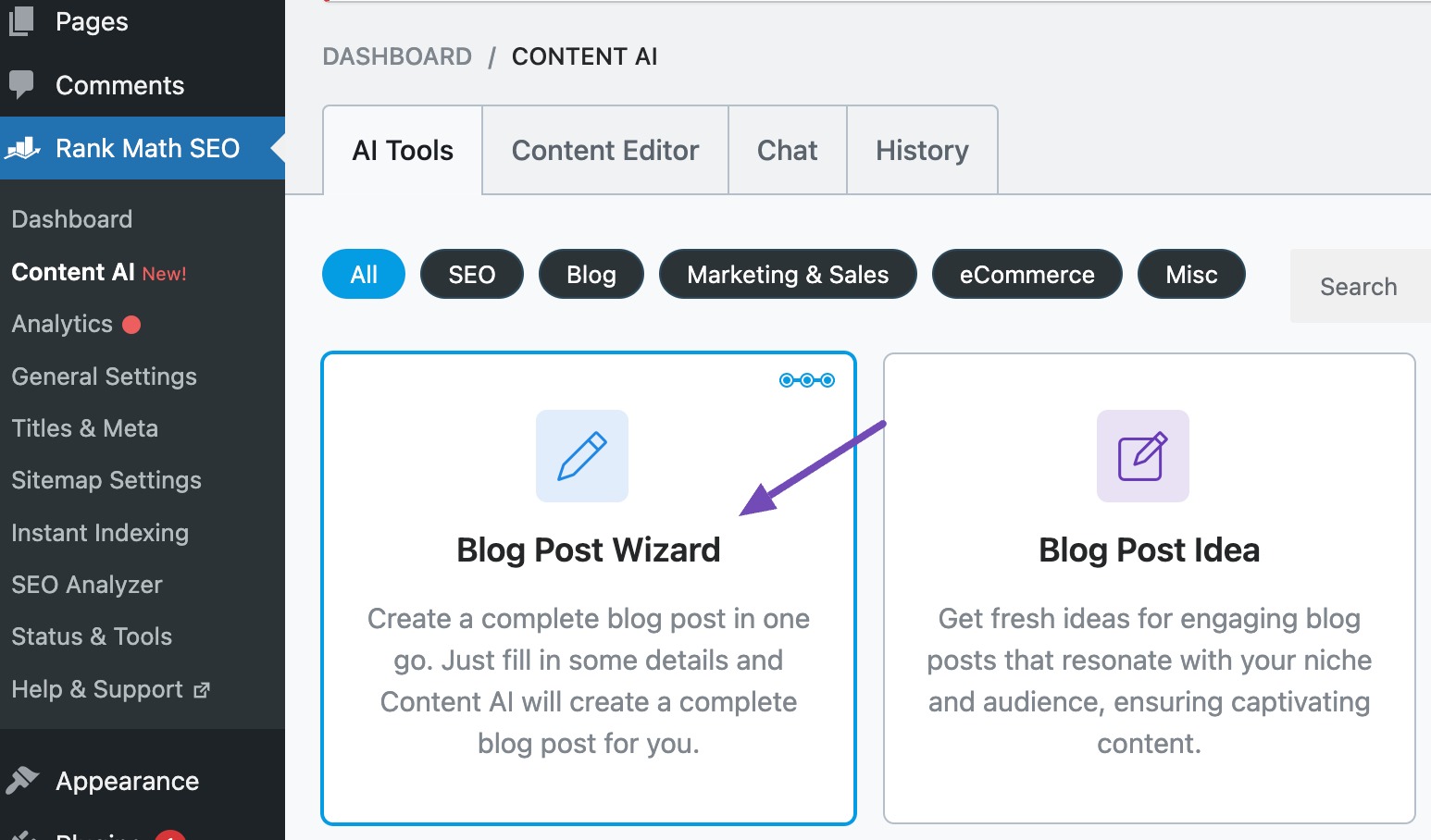
Add a few words describing your niche/industry, and the Blog Post Wizard tool will generate a blog post idea for you. You can skip to the next step if you already have an idea.
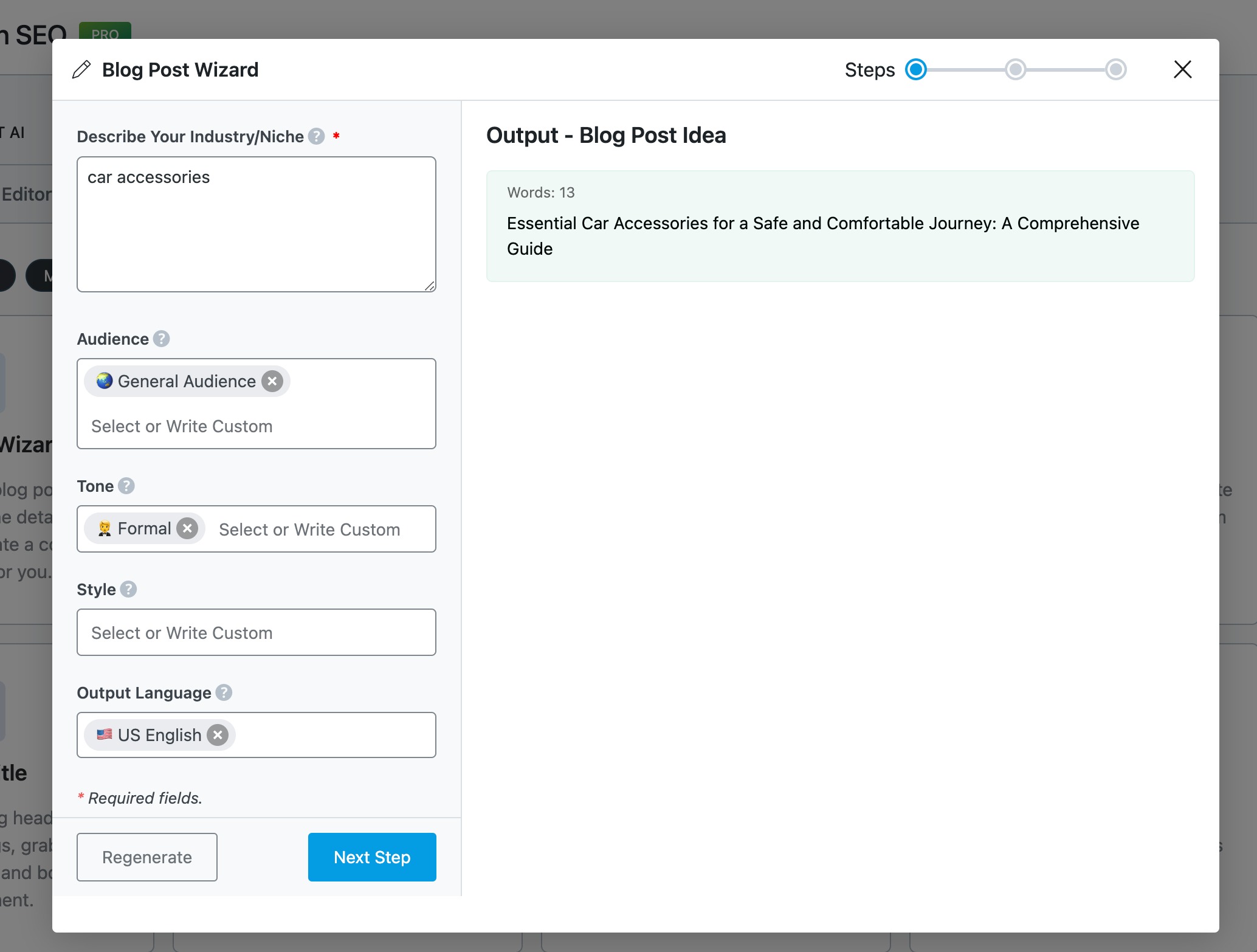
After generating a blog post idea, the tool will generate an outline based on the idea.
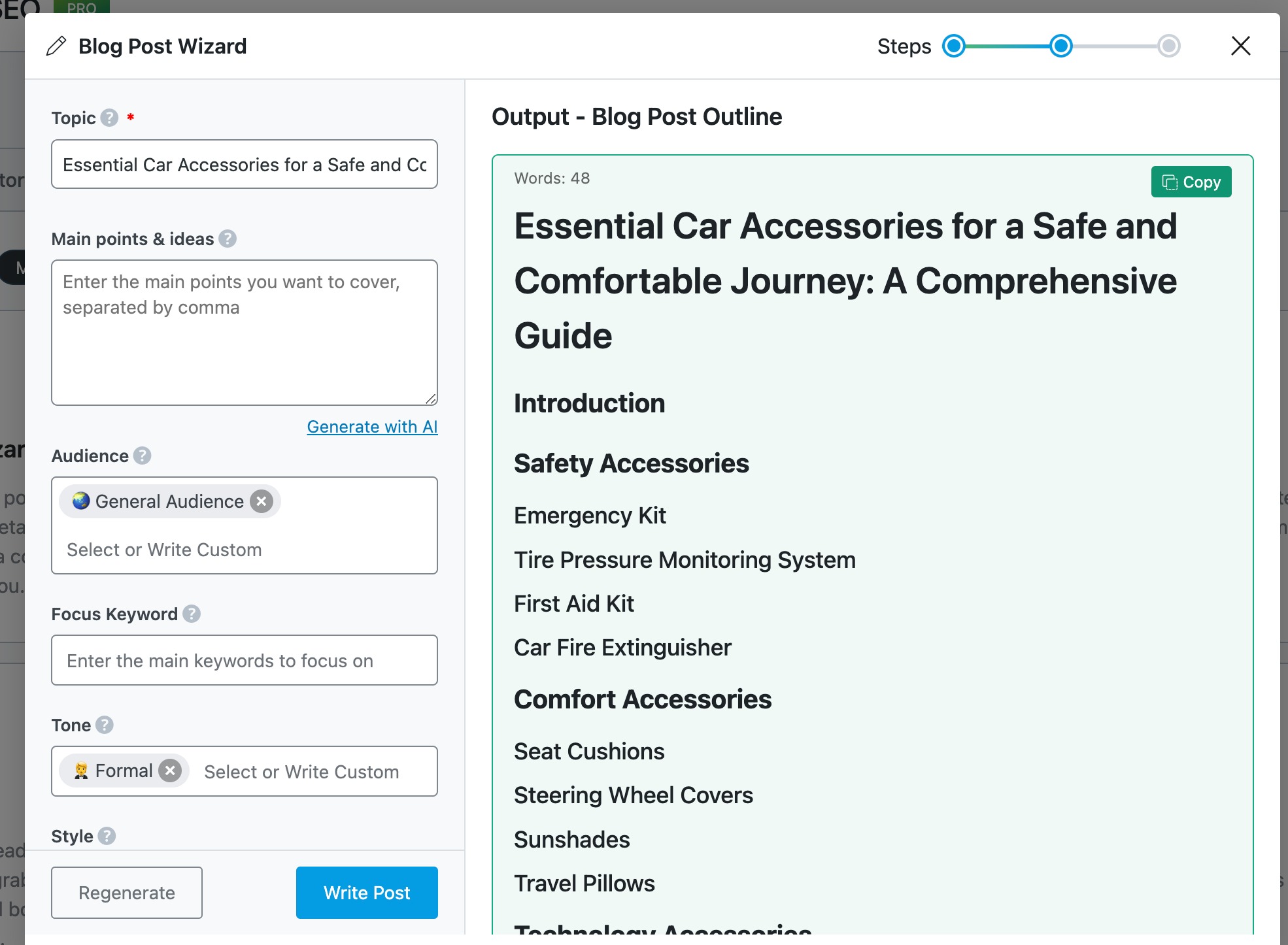
Finally, it’s time to turn the outline you just generated into a full-length blog post. Click on the Write Post button to generate compelling content for your post.
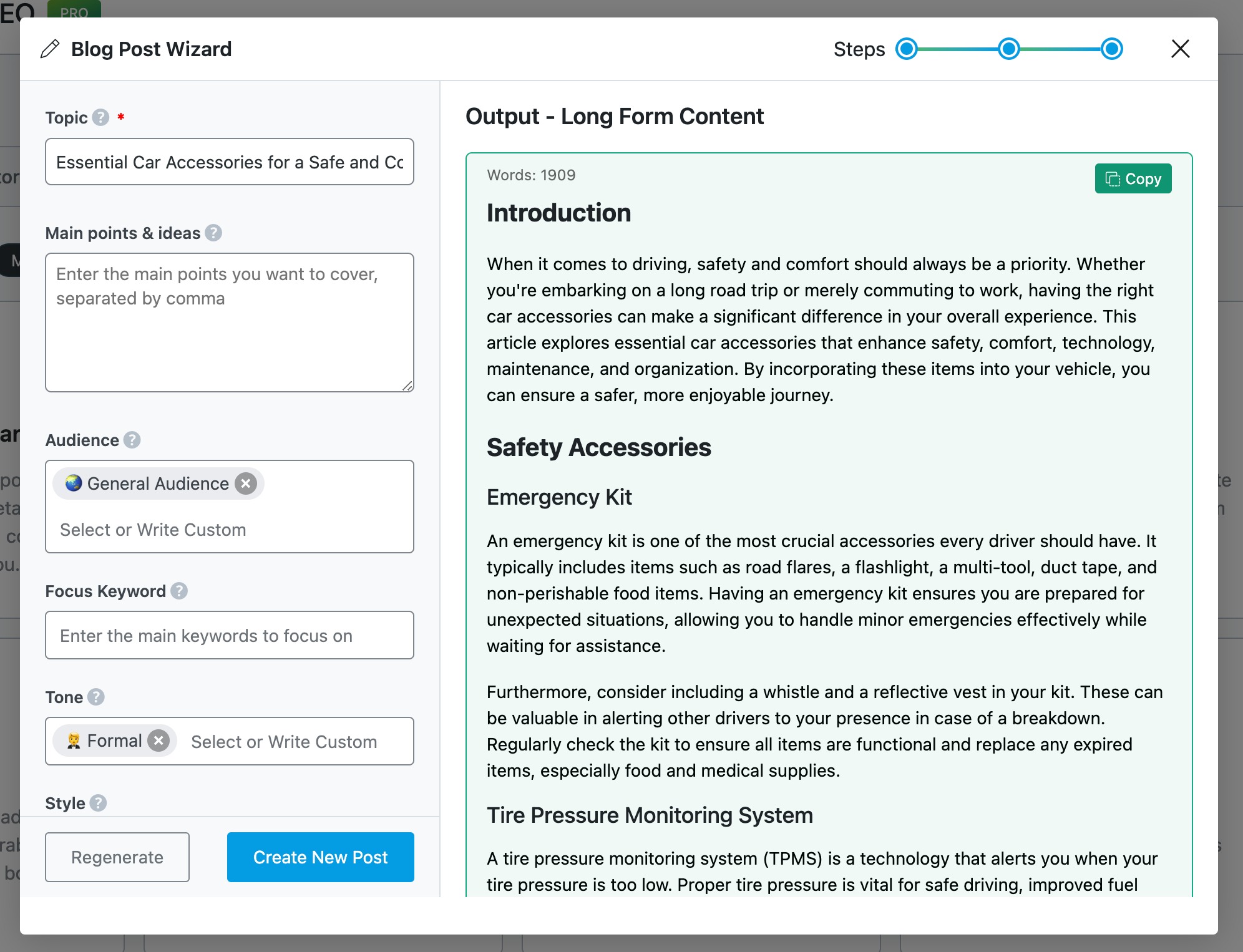
Once done, click Create New Post, and the content will be transferred to a new WordPress post.
5.4 Make It Scannable and Easy to Skim
While some readers may dive deep into your content, most will likely skim or scan it first.
So, it’s important to structure your post so that it is easy for them to scan and find what they need quickly.
Use proper heading tags to organize your content:
- H1: For the main blog title
- H2: For main sections
- H3: For subsections within each H2
This not only improves readability but also helps with SEO by giving search engines a clear content hierarchy.
Long paragraphs can overwhelm readers. Keep them short and digestible. Use:
- Bullet points to highlight lists or key tips
- Numbered lists for step-by-step instructions
- Quotes or bold text to emphasize important insights

Rank Math’s content analysis test checks for long paragraphs. It will include an eye icon with a Fix with AI button if you have at least one long paragraph. Click on the eye icon to highlight the lengthy paragraphs in the text. You can shorten the highlighted sentences using the Fix with AI option in Content AI.
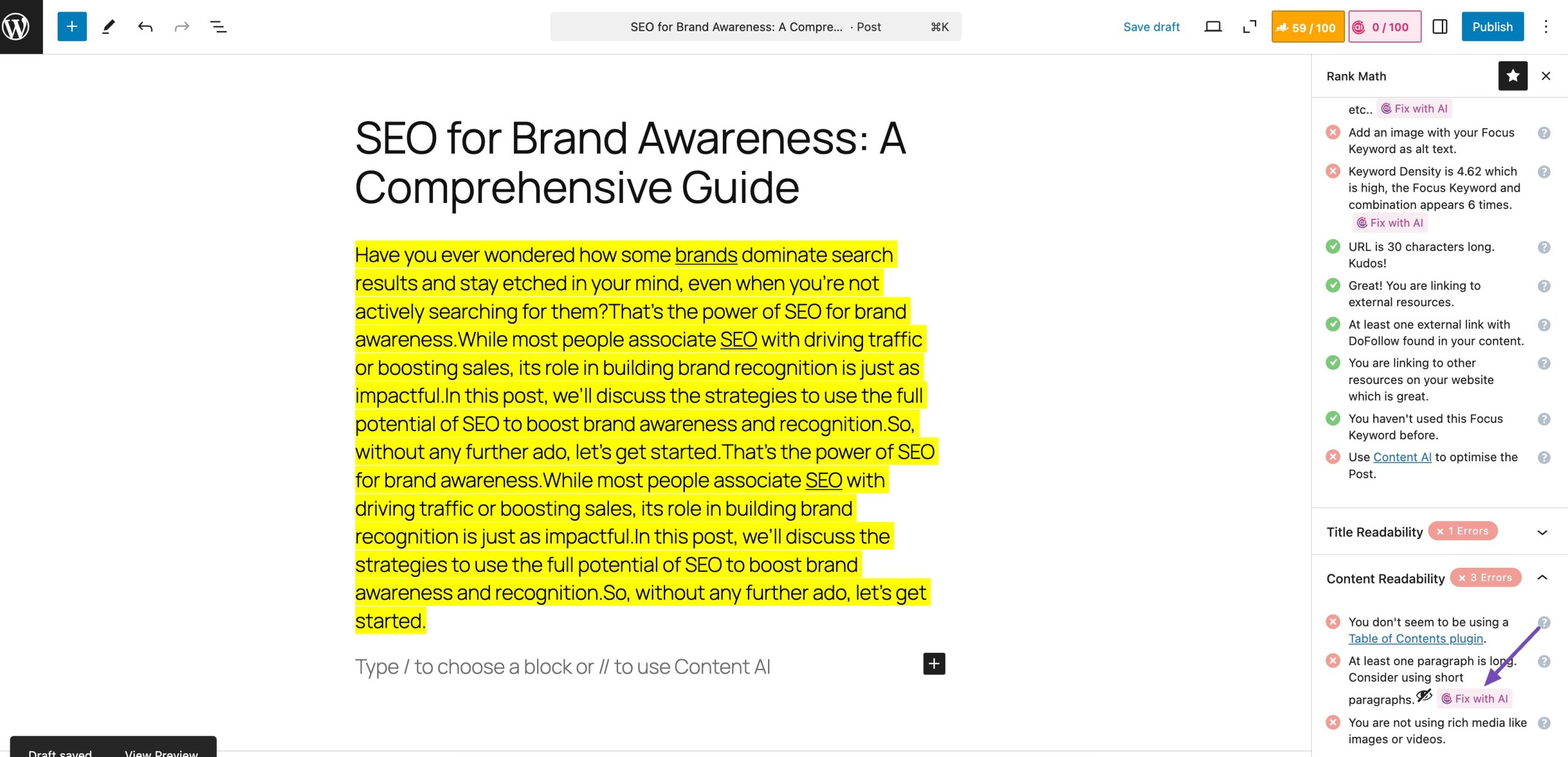
Choose a font that is easy to read and suits the tone of your content. Stick to a consistent font size and style (such as bold, italic, or underline) for headings, subheadings, body text, and any other elements of your post.
Finally, always include practical advice that your readers can use right away. The more useful your content is, the more likely readers are to stay longer and come back for more.
Refer to our dedicated tutorial on formatting a blog post to learn the tips and tricks to format a blog.
5.5 Add Visuals
Don’t underestimate the power of visuals!
They can enhance your message, break up text, and make your content more engaging. Well-placed visuals can capture attention, illustrate a point, or add a personality touch.
Place visuals strategically throughout your post to break up the text, illustrate key points, and maintain reader interest. Ensure that all visuals are properly formatted and optimized for web viewing to prevent slow loading times or distortion of images.
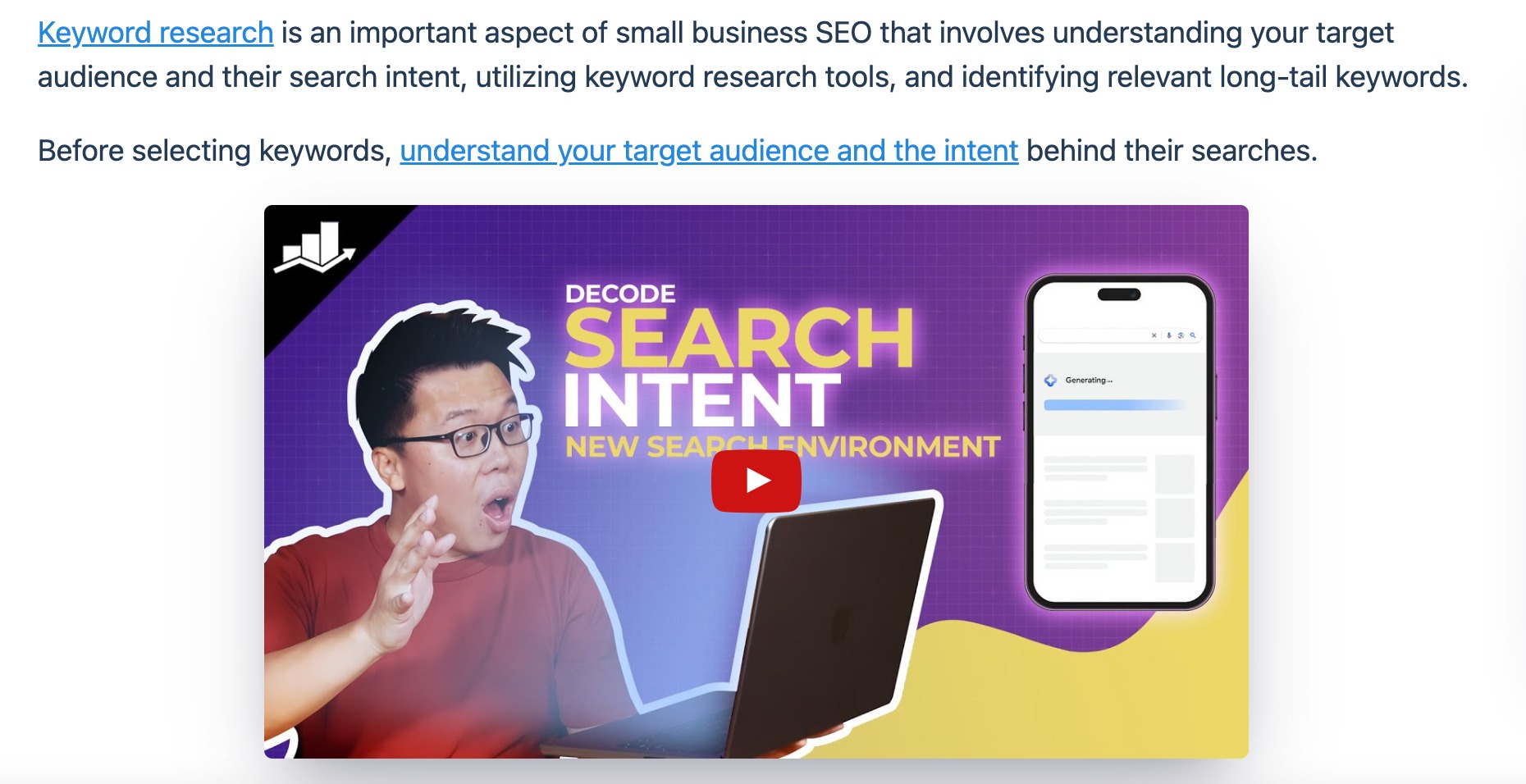
When including visuals, also ensure they are easy to understand and deliver a relevant message for the specific section of your content.
Additionally, optimize your images so they do not negatively impact your page load time.
6 Proofread and Edit Your Post
Once your draft is complete, take a step back and shift into editing mode—this is where a good post becomes a great one.
Start by reviewing your content for clarity, structure, and flow. Does each section transition smoothly to the next? Are your ideas presented in a logical order? Tighten up any sections that feel repetitive, confusing, or off-topic.
Check for grammar, spelling, and punctuation errors. Correct any mistakes you find to maintain professionalism and credibility.
Next, focus on ensuring clarity and coherence throughout your post. Clarify any ambiguous phrases or sentences and ensure that your ideas flow logically from one point to the next.
Verify your post’s overall flow and structure to ensure that it follows a logical progression and is easy for readers to navigate.
Consider using editing tools or seeking feedback from peers to identify any areas for improvement.
You can use our Fix Grammar AI tool to fix grammatical errors on the go. Ensure you’ve enabled the Content AI tool. Next, select the Fix Grammar AI tool by navigating to Rank Math SEO → Content AI → AI Tools from your WordPress dashboard.

Enter the text that you want to check for grammatical errors. The text should be at most 2000 characters. If it exceeds 2,000 characters, you should split it before entering it into the field. This is a required field. The tool will then quickly fix the errors.
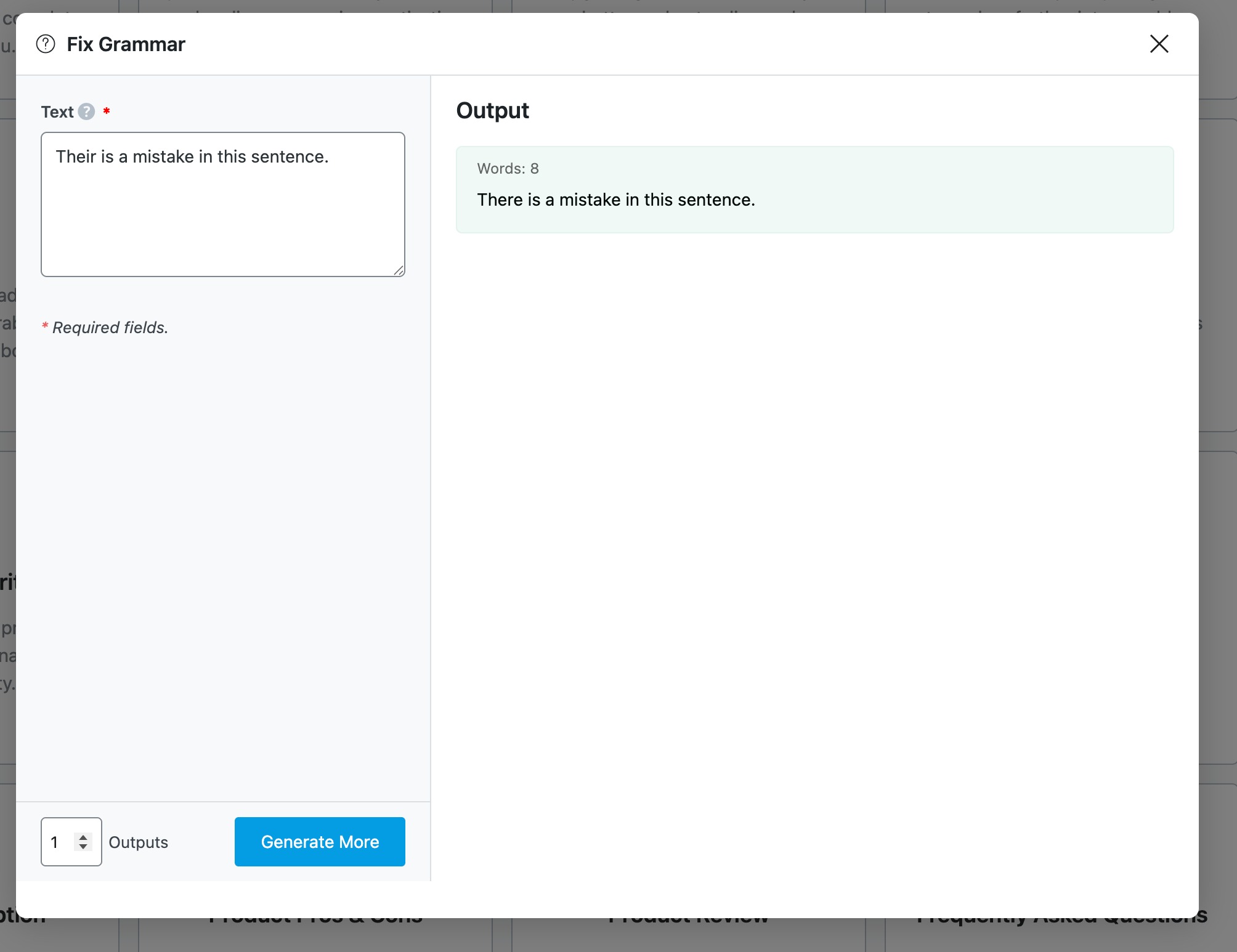
Also, check if there are areas where you might want to add FAQs, quotes, or statistics. Also, provide a quick conclusion or summary partway through the blog post. Finally, don’t forget to include your Call to Action (CTA).
7 Optimize Your Post for Search Engines
Optimizing your blog post for search engine optimization (SEO) is essential for improving its visibility and attracting more organic traffic.
We’ll quickly discuss how to optimize your post for search visibility and organic ranking.
- Use Keywords Strategically: Remember those keywords you identified during your research? Now’s the time to weave them naturally throughout your post, but avoid keyword stuffing. Focus on readability and user experience.
- Credibility Boost: Search engines value content that links to reputable sources. Include relevant outbound links to high-quality websites.
- Interlinking: Link to other relevant posts within your blog to improve website navigation and keep users engaged with your content.
- Create Compelling Titles, Meta Descriptions, and URLs: Optimize your title and meta description to entice clicks from search engine results pages (SERPs). Ensure your URL is SEO-friendly and reflects the content of your post.
- Add Alt Text to Images: Add descriptive alt text to your images. Search engines use alt text to understand the content of your images, improving accessibility and SEO.
Rank Math provides valuable insights and checks directly within your post editor. It highlights areas for improvement and ensures your post is fully optimized for search engines.

For more details, refer to our guide on using Rank Math analysis to optimize your blog posts. Once done, you can confidently publish your blog posts.
8 Promote Your Blog Post
Once you’ve published your blog post, the next step is to promote it effectively to reach your target audience and maximize its impact.
Promoting your blog post is important to ensure it reaches a wider audience and generates engagement. Utilize social media platforms to share your post with your followers and relevant communities.
Engage with your audience by responding to comments and encouraging discussions around your post.
Additionally, use email marketing to share your blog post with your subscribers. Create an engaging email subject line that prompts recipients to open and read your message.
Use our Email AI tool to create an email with Content AI. To do so, select the Email AI tool by navigating to Rank Math SEO → Content AI → AI Tools from your WordPress dashboard.
Enter a short description of the email you want Content AI to write, and fill in the other fields. The tool will create compelling email copy in seconds, as shown below.
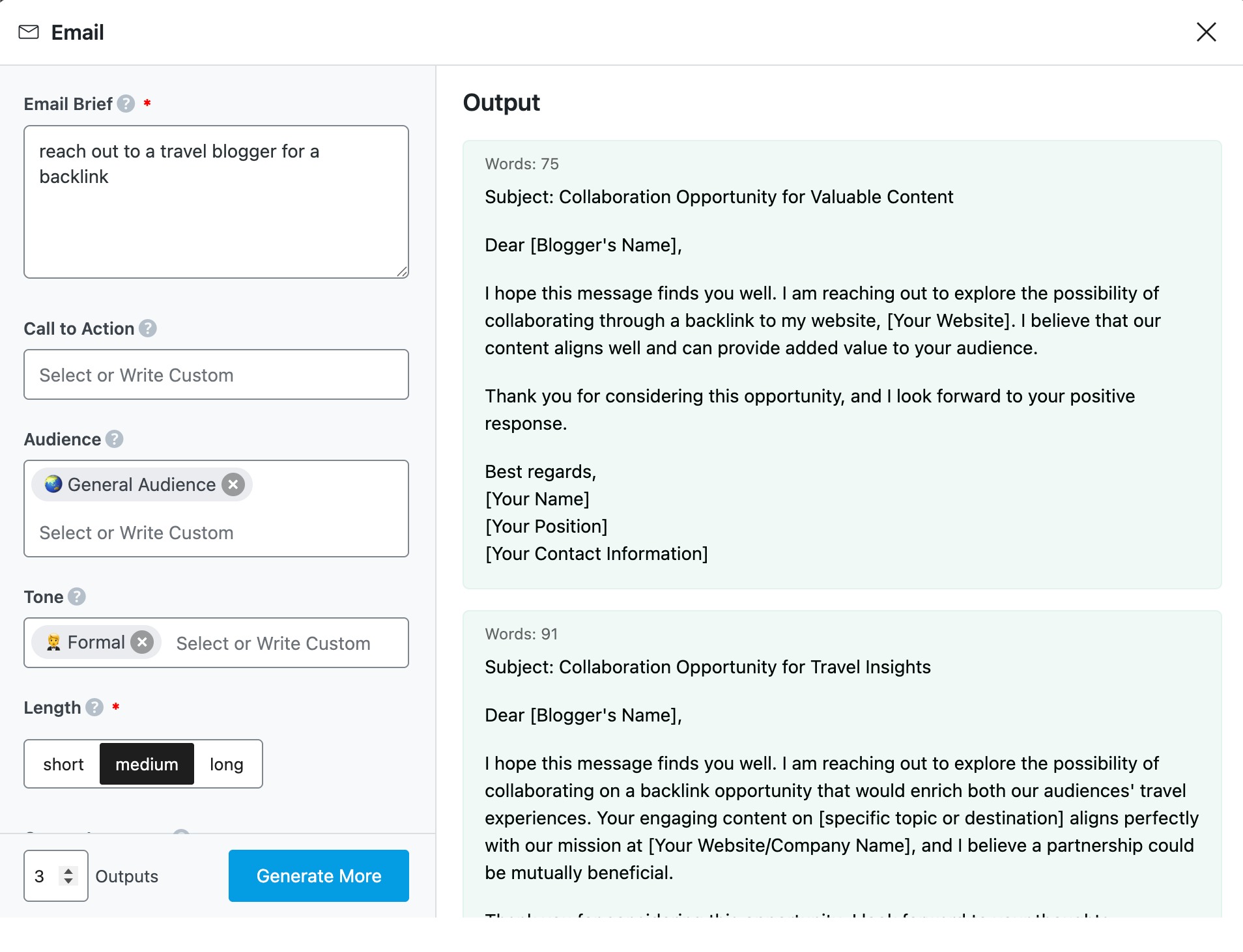
Collaborate with other bloggers or influencers in your niche to expand your reach.
Guest posting on other blogs or participating in collaborative content projects can introduce your blog to new audiences. Also, engaging in communities like Reddit is a great way to share your content, build credibility, and drive targeted traffic to your blog.
Finally, consider repurposing your blog post content into other formats, such as videos, podcasts, or infographics, to reach audiences on different platforms.
Frequently Asked Questions
How long should my blog post be?
There’s no one-size-fits-all answer. Aim for comprehensiveness while maintaining reader engagement. A good target is at least 600 words, but it can vary depending on the topic’s complexity.
How often should I publish new blog posts?
Consistency is key, but quality matters more than quantity. Aim for a realistic schedule you can maintain, whether weekly, bi-weekly, or monthly.
What if I don’t feel like an expert in Blogging?
You don’t need a perfect know-it-all to be a successful blogger. Share your knowledge, research, and experiences. Authenticity and passion resonate with readers.
How can I get more comments on my blog?
Encourage discussion by asking questions in your posts, especially at the end, and responding to comments thoughtfully.
How do I deal with writer’s block?
Experiment with different writing environments, take breaks, practice mindfulness techniques, and engage in activities that inspire creativity. Additionally, consider creating an editorial calendar, breaking tasks into smaller steps, and seeking inspiration from sources like books, podcasts, or conversations with peers.
Should I prioritize writing for search engines or readers?
Ultimately, prioritize writing for your readers. While SEO is important for visibility, creating valuable, engaging content that resonates with your audience should be your primary focus. Strive for a balance between reader satisfaction and SEO optimization.
Conclusion
Writing a successful blog post involves a strategic approach that begins with thorough planning and ends with effective promotion.
By defining your purpose and audience, conducting research, and creating a detailed outline, you set the foundation for engaging and valuable content.
Remember, the best content is a thoughtful blend of valuable information, engaging writing, and a touch of your unique personality.
By following the strategies outlined in this post, you can write blog posts that hook and keep readers engaged.
Remember that building a loyal readership takes time and consistent effort. However, keep creating high-quality content, promote strategically, engage with your audience, and be patient.
If you like this post, let us know by Tweeting @rankmathseo.
